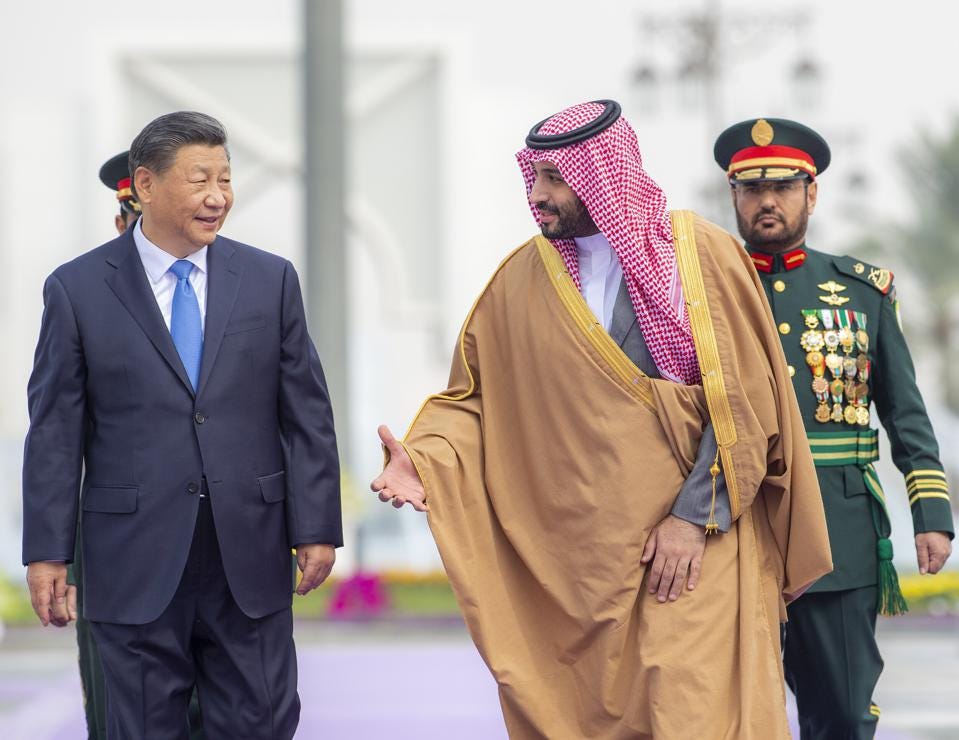Forbes Piece: The Old World Order For Crude Oil Is Disappearing
In fact, it's really already gone.
[Note: This story was also published at Forbes.com]
RIYADH, SAUDI ARABIA - DECEMBER 8 Chinese President, Xi Jinping (L) is welcomed by Crown Prince of Saudi Arabia Mohammed bin Salman Al Saud (R) at the Palace of Yamamah in Riyadh, Saudi Arabia on December 8, 2022. Chinese President Jinping is in Saudi Arabia. ANADOLU AGENCY VIA GETTY IMAGES
Russian Energy Minister Nikolai Shulginov said on Tuesday that his country has now been able to redirect all of its crude oil exports that have been impacted by Western sanctions over Ukraine to what he referred to as "friendly" countries. "I can say today that we have managed to completely redirect the entire volume of exports affected by the embargo. There was no decrease in sales," Shulginov was quoted by Reuters as saying.
The Rise of BRICS
There is no question that Russia’s fellow members of the increasingly influential BRICS (Brazil, Russia, India, China, South Africa) Alliance have played a major role in helping the Putin government to achieve this outcome. India was the biggest buyer of Urals grade crude in March, accounting for almost 50% of all such exports. Russia’s Deputy Prime Minister, Alexander Novak, stated that Russia’s sales to India have risen 22-fold over the past year.
In a separate story in early March, Reuters reported that China’s seaborne imports of Russian crude were set to hit new record highs in March, based on ship tracking data. “Tanker tracking consultancies Vortexa and Kpler estimated nearly 43 million barrels of Russian crude oil, comprising about at least 20 million barrels of ESPO Blend and 11 million barrels of Urals, are set to reach China in March,” Reuters said, a number that would exceed the previous high of 42.48 million barrels recorded in June, 2020.
This new alignment among the BRICS countries in support of Russian crude trading is not surprising given that none of Russia’s fellow member countries have chosen to support the sanctions being imposed mainly by the governments of the Western world. Started in 2001 as a loosely-formed trading alliance among rapidly-developing economies of Brazil, Russia, India and China, the group added South Africa to its membership in 2010. Since then, it has increasingly positioned itself as a geopolitical alternative to the G7, whose members include the United States, Japan, Italy, Canada, Germany, France, the United Kingdom and the European Union.
In 2014, for example, BRICS used $50 billion in seed funds to create the New Development Bank as an alternative to the World Bank and the International Monetary Fund. As the same time, the group also created what it calls the Contingent Reserve Arrangement to support members struggling to meet debt obligations.
In a recent interview with WION News, South African Foreign Minister Naledi Pandor said she and leaders of other BRICS nations are experiencing “huge interest” from other countries related to those tools of finance. Saying that she had “12 letters” from such countries currently on her desk, Pandor ticked off the names of more than half a dozen of them: “ Saudi Arabia is one... United Arab Emirates, Egypt, Algeria, and Argentina,” and went onto add Mexico and Nigeria.
Saudi Arabia Looks Increasingly to the East
No country has expressed greater interest in conducting business with the BRICS group than Saudi Arabia has in recent months. In March of last year, the Wall Street Journal reported that the Kingdom had been engaged in talks with China about the possibility of conducting some of its oil sales using the Chinese Yuan as the currency. Such a move would disrupt the long-existing oil order that has used the U.S. dollar, or “petro-dollar,” as the currency of mark for international oil trades since 1973.
Keep reading with a 7-day free trial
Subscribe to Energy Transition Absurdities to keep reading this post and get 7 days of free access to the full post archives.




